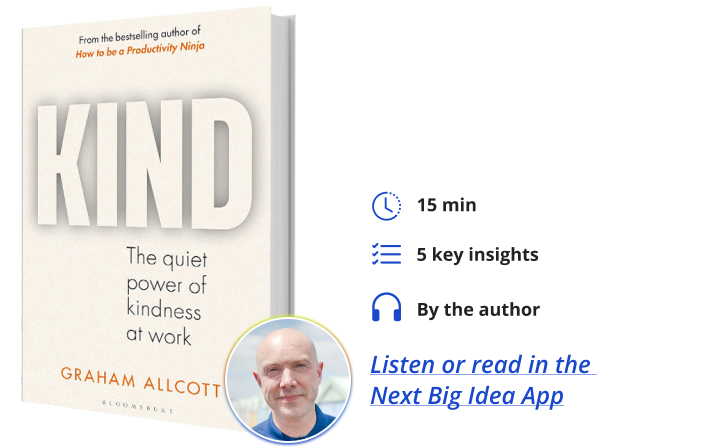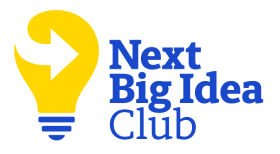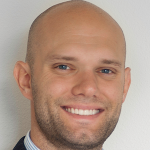Graham Allcott has written six books, including the global bestseller How to Be a Productivity Ninja. He is the founder of Think Productive and has privately coached prominent international business leaders.
What’s the big idea?
Kindness, empathy, and psychological safety at work are not just fluffy, hippie ideas. They are key drivers of outstanding performance. Kindness is a practice that requires strength, skill, and intentionality. With it, every team can create an environment of abundant wellbeing, innovation, and growth.
Below, Graham shares five key insights from his new book, KIND: The Quiet Power of Kindness at Work. Listen to the audio version—read by Graham himself—in the Next Big Idea App.

1. Kindness and empathy build trust and psychological safety.
High-performing teams are built on trust and psychological safety. Kindness is one of the fastest ways to build this high-performing environment.
Trust allows people to take risks, admit mistakes, and remove micro-management and other forms of due diligence. In a team, psychological safety—feeling able to take interpersonal risks—leads to high performance. When a team is psychologically safe, people raise the alarm if they spot a problem and share the risky idea that might drive innovation. They tell hard truths but are also more open to feedback for improvement. They feel seen, heard, and part of a bigger picture.
All the research points to psychologically safe, people-driven business as being more successful. Psychological safety leads to greater productivity, engagement, retention, well-being, creativity, innovation, and happiness. Kindness and empathy aren’t just moral nice-to-haves. They’re strategic advantages for building a culture of psychological safety where the work matters because the people doing it matter.
2. Nice and kind are not the same.
Kindness often gets bad press, or people might even say there’s no place for kindness at work. Kindness is often considered weak or a quality of pushovers. But this is because people confuse being kind with being nice.
Nice often is a bit weak—nice cultures often focus on keeping the peace but shirk the responsibility to tell the truth or call out bad behavior. On the other hand, kind cultures focus on truth and grace. Nice is about telling people what they want to hear. Kind is about telling people what they need to hear.
Imagine you’ve been in a meeting, and a colleague delivered a presentation to the group. It didn’t go well. At the end of the meeting, your colleague asks you for feedback. At this moment, we face a choice. The nice option is that we tell a white lie to keep the peace: it was good; you did well. We are shirking the truth to keep the peace.
“Kind is about telling people what they need to hear.”
The kind route would be to invest 20 minutes the following day to go through some quick feedback. We can offer difficult and uncomfortable truth, but from a place of love. The result is that they can learn and improve. It takes real strength to choose kind over nice in that moment. It’s inconvenient (it takes time), it’s brave (because you have to put your relationship with that person at risk to help them improve), and it’s skillful (because delivering the truth with grace takes a skilled communicator). But when everybody operates like that, no one fears feedback, people grow, and the team’s performance and work output continuously improves. Being too nice can be a weakness, but being kind is pretty badass.
3. Challenging the Business Baddie narrative.
Kindness drives performance. It also lowers stress levels and improves physical well-being. And it’s free. So, why isn’t there more kindness? What’s holding us back?
If you look at portrayals of business and work in theatre, fiction, and media, what you’ll find everywhere is the business bastard archetype. Back to Shylock and Ebeneezer Scrooge, right through to Shark Tank and The Wolf of Wall Street, we’re taught that those who treat people badly are the ones who succeed. Upon reading the biography of Steve Jobs, I witnessed many founders thinking that if they shouted at staff during their all-hands meeting, they’d build the next Apple.
In the book, I debunk the idea of dog-eat-dog success. The majority of successful leaders, statistically, are likable. But reasonable people doing a great job, being kind, and inspiring loyalty along the way produce less interesting stories than an evil genius. From Warren Buffett to Jacinda Ardern to Brian Chesky at Airbnb to the kind managers and leaders that you know, there are remarkable leaders whose warmth and kindness set the tone for success.
The business bastard narrative keeps us locked into a scarcity mindset, whereas kindness rewires our brains toward abundance. We need to move away from the self-talk that says there isn’t enough time, or there isn’t enough, or that we are not enough. We need to replace that self-talk with talk of abundance: I am enough. There is enough. When we see the world through this lens, then kindness is much easier.
4. Kindness is a verb.
A lot of what we see online regarding kindness—the #be kind hashtag, social media memes, virtue signalling—is people adopting kindness as part of their identity. There’s no such thing as a kind person or an unkind person. There are just kind or unkind actions. All of us have the capacity to be kind or unkind.
Kindness isn’t something you are, it’s something you do. You are as kind as your last kind act or as unkind as your last unkind act. When we see kindness as a verb, not a noun, we recognize the importance of seeing kindness as a practice.
“There are no prizes for just having the thought.”
Kindness happens in the gap between having the idea to make someone’s day and actually making someone’s day. There are no prizes for just having the thought. It’s the action that counts. The more we see kindness as a practice, the more we spot the gap when it happens. It’s that tiny moment when you spot an opportunity to be kind. You’re on a train, and someone needs your seat more than you do, or you’re in a meeting, and there’s a tiny window of time to say something kind about a colleague. Act in that moment, and you make their day. Ponder for a couple of seconds too long, and the agenda moves on, and the moment is gone. Learning to leap into that gap rather than be held back by our own resistance is kindness.
To notice more opportunities, it helps to slow down. The biggest source of accidental unkindness is busyness. When we reduce busyness and increase presence, it increases empathy, and we build stronger relationships with those around us.
5. Kindness starts with you but doesn’t end with you.
I created 8 Principles of Kindfulness at Work. The first of these is that kindness starts with you. When we think about kindness, often our first thought is external: who needs our help? How can we be kind to a stranger? But the uncomfortable truth is that we have to start with self-kindness. Most of us are wired to treat others better than we treat ourselves. We think of self-care as somehow self-indulgent. But practicing self-kindness signals to others that self-kindness matters, and they can follow your example.
It also helps us move our self-talk away from scarcity and toward abundant thinking. For the kindness it inspires in others, being kind to yourself is a radical act of generosity. Kindness starts with you. The people who are kinder to themselves find it easier to be kind to others.
But of course, kindness doesn’t end with you. In the coffee shops of Naples, they have a tradition called caffe sospeso. It basically means “suspended coffee” and it’s a pay-it-forward model. There’s a jar on the counter of the coffee shop and when I order my coffee, I tell the barista that I also want to order a caffe sospeso. When I do that, the barista gives me a suspended coffee ticket and I put it in the jar. Then, the next time someone comes in and doesn’t have their wallet or money, they take out the ticket and claim a free coffee.
It’s a wonderful example of the power of a single, kind act to create a ripple effect. I feel good and get that helpers high, the barista feels good about where they work, the customers who witness it are inspired to do something kind, and then someone claims it, and everyone gets to witness the act of kindness all over again. There’s a lot of research that talks about how many ripple effects can come from a single act of kindness.
All the coffee shop owner really did was find a jar and write caffe sospeso on it! They literally created a vessel for kindness and, in doing so, made it easy to be kind. That’s kindfulness. The idea that we can create vessels for other people to be kind. We can, in our work, make it easy for other people to be kind.
Whether it’s instigating a thank you card for someone, or taking a few moments in a team meeting to ask everyone to say something they value about the person to their left, we can all create the vessels for kindness. Think about your own work: what’s the equivalent of that jar at the coffee shop? How can you be a vessel for kindness, and make it easy for everyone around you to be kind?
To listen to the audio version read by author Graham Allcott, download the Next Big Idea App today:































